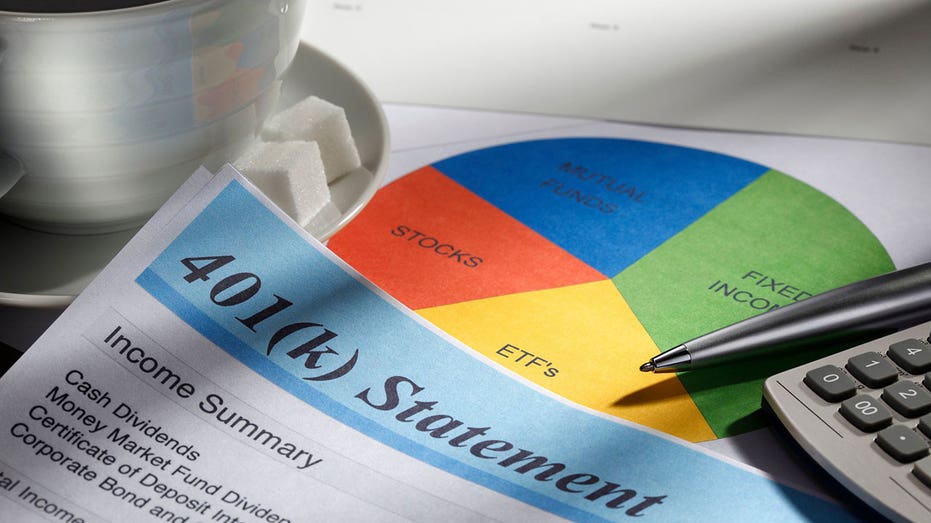
SlateStone Wealth chief market strategist Kenny Polcari provides stock market advice on ‘Making Money.’
If you’re in your 20s or 30s, it may seem like retirement is so far off, but experts say that early planning is the best way to be on track to live comfortably in your golden years.
During your 40s and 50s, retirement is approaching and this is the time to start organizing your assets so that you can live without financial stress. And, in your 60s and beyond, retirement has likely arrived, and there are specific money matters that can impact your financial well-being.
Jean Statler, CEO of the Alliance for Lifetime Income, explains as Peak 65 arrives next year – a historic demographic event when the largest number of Americans ever will reach 65 – far too many people still don’t have the savings and protected income they need to retire comfortably.
“The retirement savings crisis is about to become a retirement income crisis, so we have to continue to do everything we can to help people better prepare – especially those close to retirement,” says Statler.
WHY IT’S IMPORTANT TO START A RETIREMENT PLAN IN YOUR 20S
For a plethora of reasons, your situation will change over time and your plans will have to be tweaked along the way.
“It’s critical to understand how your income needs and spending habits will change,” says Debra Greenberg, director of personal retirement at Bank of America.
Greenberg tells FOX Business that it can be easy to get overwhelmed when thinking about retirement.
“Many financial advisors offer free consultations and you should take advantage of that. Also, it’s always a good idea to consult with a tax adviser before making any decisions regarding your assets,” she says.
Merrill Lynch, whose parent company is Bank of America, has provided 12 steps that can take you from your first job to retirement.

A couple meet with their financial adviser. (iStock / iStock)
1. Take advantage and make the most of employer-sponsored retirement plans
Contribute to your retirement plan as soon as you are eligible.
“Even seemingly small amounts can add up over the years, and taking action now helps to increase the likelihood you’ll be better prepared to meet any unexpected challenges that come your way,” Greenberg tells FOX Business.
Try to max out any employer match so that you don’t leave money on the table.
“Contribute enough so that you can take advantage of a full company match if one is offered,” adds Greenberg. “For more information on contribution limits, consult your tax or financial adviser.”
HEALTH CARE FOR A 65-YEAR-OLD RETIREE CAN COST $157,500: FIDELITY
Jason Fichtner, head of the Retirement Income Institute and chief economist at the Bipartisan Policy Center, says that as fewer Americans have pensions, demands in the workplace for employers to provide retirement income protection is irrefutable.
“Thankfully, employers have an increasingly robust toolbox to create the financial protection their workers want,” Fichtner says.
Experts recommend contributing the maximum allowed to qualified plans when possible.
2. Consider saving more toward all your goals using additional tax-advantaged accounts
Consider saving more in traditional and Roth IRAs (including spousal IRA contributions if eligible).
Want to save more?
“If you’re married and not working but file a joint return, you may be able to contribute to an IRA even if you did not have taxable compensation – as long as your spouse did,” explains Greenberg.
She says to ask your tax adviser for details to determine if you are eligible.
“If applicable, additional contributions are allowed if you will be age 50 or older at any time during the year,” adds Greenberg.

A person puts money into a retirement savings jar. (iStock / iStock)
Consider health savings account contributions, if eligible. Save money on many out-of-pocket medical expenses.
“If you have a qualified high-deductible health plan, you may be able to contribute to an HSA, provided you do not have other disqualifying health coverage,” she says.
RETIREMENT, 401(K) SAVINGS RISE LED BY BOOMERS, GEN Z
And don’t forget to take advantage of any employer contributions when they are offered.
“HSA funds can be used for qualified medical expenses, and if you are Medicare-eligible (age 65 or older) you may be able to pay Medicare premiums with tax-free distributions,” Greenberg tells FOX Business.
Save for future educational expenses with 529 college savings plans.
“A financial professional can help you balance all of your financial goals such as retirement, legacy and education savings goals,” Greenberg explains.
3. Be aware of catch-up contributions if you’ll be age 50 or older any time this year
Age 50: Begin catch-up contributions to IRAs and qualified retirement plans and review annually since the amount will now be indexed for inflation, per Merrill.
“You may also be able to contribute additional catch-ups to employer plans starting in 2024 if the plan allows,” Greenberg tells FOX Business.
4. Set up important legal documents
Review and update your beneficiaries.
“This should be at least an annual exercise. As family dynamics change with births, adoptions, weddings, divorces and deaths in the family, your wishes for the direction of your assets after your passing may change,” clarifies Greenberg.
Set up a trusted contact person form.
Retire SMART, LLC President and founder David Brooks shares tips on saving for retirement and discusses the impact of raising the retirement age.
Establish a living will/health care directive, which states your wishes for end-of-life medical care in case you become unable to articulate your decisions, says Merrill.
Designate a health care proxy: Pick someone you can trust to make medical decisions in the event you are unable to express your treatment preferences, according to Merrill.
Establish a durable power of attorney: Designate someone to act on your behalf in the event of diminishing capacity, per Merrill.
5. Estimate your future lifestyle costs
Consider all expenses: Talk to an adviser about estimating out-of-pocket health care expenses and setting priorities for your living expenses, Merrill recommends.
6. Plan and understand your income sources during retirement
Take into account your investments, business, Social Security and pension/annuity income.
Determine the withdrawal rate from your retirement plans.
“When you start drawing down your assets in retirement, the tax implications can be confusing,” cautions Greenberg. “Make sure you check with your tax professional as withdrawals from some accounts are not eligible to be reversed. Also remember that as you draw down, the assets are not there to continue to grow for your retirement.”
7. Recognize any risks that may impact this plan
Take measured steps against healthcare costs, longevity risk, sequence of return risk and inflation risk.
“You may decide to invest more aggressively to increase the odds that you won’t outlive your assets, or you may take a more conservative approach,” Greenberg tells FOX Business. “Everyone’s situation and tolerance to these risks will be different, so there isn’t going to be a one-size-fits-all approach.”
8. Set a plan for your legacy and wealth transfer goals
Create a will and trust if this is right for you. Make some decisions about how you want your property to be distributed as you consider wealth transfer and legacy planning, Merrill says.
9. Understand health care costs in retirement
Understand the costs and need for long-term care.
“It’s critical to make sure that your financial plan covers the costs of any additional care you may need,” Greenberg adds.

A doctor meets with a patient. (iStock)
Understand Medicare coverage: Medicare won’t cover all expenses, so plan for out-of-pocket expenses like premiums, deductibles, co-pays, and supplemental insurance for non-covered expenses like dental and vision care, according to Merrill.
AVERAGE 401(K) ACCOUNT BALANCES TUMBLED LAST YEAR, VANGUARD RESEARCH SHOWS
Age 65: You become eligible for Medicare. If you retire before 65, you’ll need to plan for a gap in coverage until you are eligible, says Merrill.
Annual election period after 65: According to Merrill, between Oct. 15 and Dec. 7, you must re-enroll in Medicare every year, so it’s a good time to review your coverage needs, according to Merrill. Also, there’s a penalty enforced for life if you miss a year.
10. Decide on a Social Security withdrawal strategy
“Delaying your benefits can give you greater income for life, but that won’t be the right choice for every individual,” Greenberg tells FOX Business. She says to review Social Security options.
Age 62: You may begin receiving reduced Social Security benefits on your own record, a spouse’s record or an ex-spouse’s record, says Merrill.
Full retirement age (FRA): The full benefit age is 66 for people born in 1943-1954, for people born between 1955-1959 FRA is 66 plus two months per year after 1954 until 1960, and it is 67 for those born in 1960 or later, Merrill says.
CLICK HERE TO GET THE FOX BUSINESS APP
Age 70: You have maximized your delayed retirement credits and should begin receiving benefits.
“Waiting to claim Social Security can be a way of protection against the risk of longevity,” Greenberg says. “But in making that decision, you have to consider your family history and your own health.”
11. Get a grasp on new required minimum distribution (RMD) rules
Age 70 ½: According to Merrill, eligible IRA owners can make qualified charitable distributions paid directly to a qualified charity (up to $100,000 and a one-time option for $50,000 to charities through various charitable split–interest trusts).
Age 73: You must begin taking required minimum distributions from IRAs, 401(k)s and 403(b)s.

401(k) plans ensure Americans have enough money to live on after they retire and no longer receive an annual wage. (Getty / Getty Images)
“And by 2033, this will rise to age 75,” notes Greenberg.
12. Continue to stay up to date regarding your financial matters
Regularly review your expenses and income needs, withdrawal strategy, beneficiaries, health care proxy, will and trust to ensure your plan meets your current needs, according to Merrill.
“Everyone should have an up-to-date financial plan. This includes a budget based on essential and discretionary expenses, and how much you’ll need to save for retirement, keeping in mind your life stage,” says Suzanne Norman, education fellow at the Retirement Income Institute. “Make sure you have enough guaranteed income, such as an annuity, to cover your basics. Routinely review your financial plan to ensure it is up to date to reflect any recent life changes, such as a recent divorce, childbirth or caring for aging parents. Consult a financial professional to see how different saving and spending scenarios may impact your retirement.”
In addition, Norman says that fewer retirees, as well as people approaching retirement, have pensions today, and Social Security often isn’t enough.
CLICK HERE TO READ MORE ON FOX BUSINESS
“Protected income helps cover basic monthly expenses – things like a mortgage or rent, utilities, groceries, or transportation,” she adds.
Also, financial planning shouldn’t be a set-it-and-forget-it exercise, Greenberg tells FOX Business.
“Ideally you’d want a plan in place so that you can cover both your essential and discretionary expenses,” Greenberg says. “This may mean that you have to work longer or work part-time in retirement to limit withdrawals and allow your assets to grow for a longer period of time.”

 Latest Breaking News Online News Portal
Latest Breaking News Online News Portal




